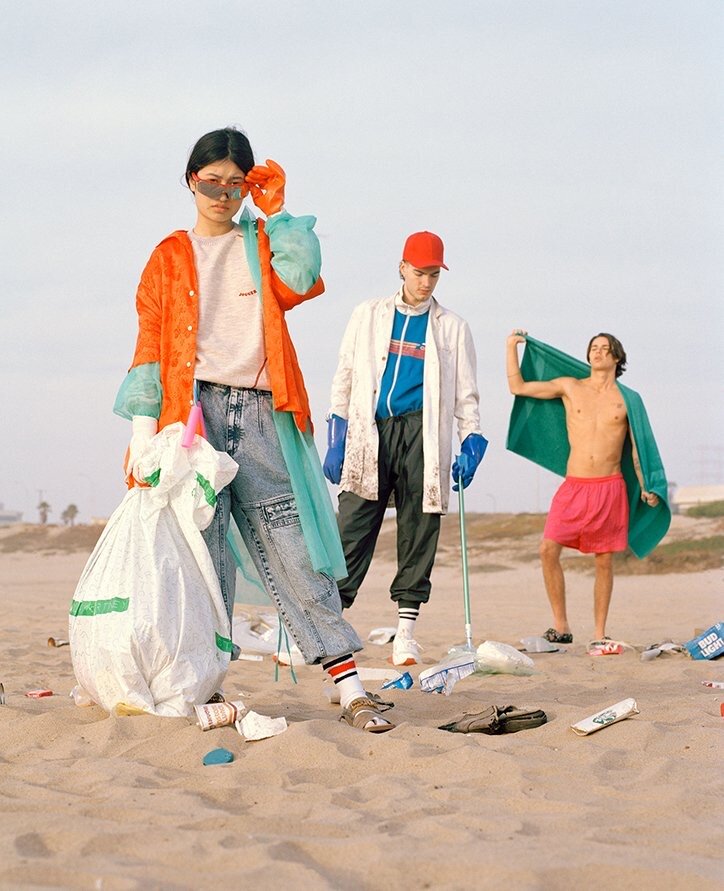
Fashion’s Unsustainable Behaviour.
By Dr Alana M James
From the outside fashion adopts a glossy and glamorous image, however the industry has many dirty habits that contribute to a very uncertain and unsustainable future for the planet and social communities around the world. The operations carried out during the production, use and disposal of garments means it is the second most polluting industry in the world, second only to oil. These toxic actions are causing 8.1% of the world’s total carbon emissions and significantly contributing to the effects of climate change.
What has fashion got to do with climate change?
The speed and quantity of garments consumed by individuals is said to be the biggest issue, frequently meaning that undue pressure is placed on the supply chain to meet the level of demand. This pressure often means that compromise and short-cuts are taken that are at the expense of people and the planet. UK consumers are amongst the worst offenders, buying more items per person than any other European country. If these consumption habits continue, by 2050 the resources of three planet earths will be needed, but what effect will this have on our future?
Photo by Markus Spiske on Unsplash
The behaviour of human and global industries (such as fashion) are causing the earth’s temperatures to rise through the use of natural resources, levels of pollution and a rising quantity of waste. The consequences of even a 0.5°C temperature increase can be the difference between life and death for some species and in time will mean that large areas of the earth are completely uninhabitable. In response to this urgent climate call, many conflicting political agreements have been made, but what remains consistent is the message for the need to change in order to avoid horrific environmental consequences. The evidence of climate change is already being seen globally: deadly hurricanes in America, wildfires across the Arctic Tundra and Arctic ice sheet melt, occurring 90 years ahead of the predicted schedule. In 2019, The United Nations called for urgent action stating that we have just 11 years to change our ways before irreversible damage is caused to the planet through the effects of climate change.
How have we got to this situation?
Many of the debates aiming to answer this question begin to talk about the Anthropocene, which refers to the imbalance between nature and humans and the scale of environmental change brought about by human and industrial activity. How and why the Anthropocene has emerged has been heavily debated, with many believing it to coincide with the start of the industrial revolution. This is where the use of fossil fuels such as coal, oil and gas, became the norm and key machinery for the creation of textiles were developed. This included equipment such as the spinning jenny, the power loom and the cotton gin, all allowing textiles to be created in large quantities for the first time.
To help explain why things have changed in fashion since the industrial revolution, we need to have a short history lesson...
Following the invention of the necessary machinery, how this equipment was powered for greater efficiency was the next challenge. By 1870 textile manufacturing operated more steam engines than any other sector of the economy, using fossil fuels in preference to more traditional water power methods used in earlier textile mills.
Photo by Marcin Jozwiak on Unsplash
By the 1920’s, new materials had begun to emerge and were increasingly being used for fashion items. Synthetic fibres such as acrylic, polyester and nylon were being widely produced, indicating the expansion of the oil industry, seeing a shift to the use of finite resources for fashion production.
Fast forward to the 1980’s where more big changes were afoot, with globalisation helping the production of fashion to move overseas to countries such as China. This meant that fashion brands could cut costs with cheaper labour being used and increase their profit margins. By the mid 1990’s the majority of production had moved abroad and by the early 2000’s, the UK clothing and textiles sector employed its lowest number of workers with only 90,000 remaining in textile mills and garment factories.
Offshoring; the move of production away from the UK, may have made good business sense at the time, but it also brought with it many challenges, especially with social and environmental standards. The economic crash and period of recession in the UK in 2008 saw a new type of store rising to popularity, one that favoured large quantities of low-cost clothing in preference to quality. Fast fashion acted as a catalyst for the speed and volume of fashion consumption with the use of synthetic fibres and a cheap labour force in countries such as Bangladesh, India, China and Morocco. Fast fashion has become the norm with the high street providing easy accessibility to many low value, fast fashion retailers. However, in recent years new, more accessible and often cheaper alternatives to fast fashion have emerged, with brands such as Boohoo, Misguided and Pretty Little Things now being labelled as ultra-fast fashion. These predominantly online retailers offer thousands of new styles on their websites every week, selling a dress for as little as £5.
So, how can we make a change?
Just as styles in fashion change, the way garments are produced, sold and consumed also continues to change to reflect the society we live in. Fashion consumers are largely driven by price and convenience, a demand which has been met by a huge growth in ecommerce. However, in the past few years, people are becoming more and more aware of the unsustainable nature of some of our daily activities. The negative effects of plastic for instance has become a hot topic, with programs such as Blue Planet showing the environmental damage caused by the quantity of plastic ending up in seas and oceans.
The quantity of clothing that we buy, how long we keep it for and how we throw it away can have big environmental and social consequences, but these are all decisions we can make and control. Every item of clothing we buy acts as a vote, as we support the values and actions of a particular brand or retailer. To help us make more responsible decisions, knowledge is our friend so try and get clued up on sustainable issues that you feel particularly passionate about.
And next time you go shopping, think before you buy, fashion cannot carry on as it is and you have the power to help it change.
This article is part of a series written by Alana with a new sustainability issue discussed each month. Next up: Fast is not Free.
Related Articles.
Fashion’s Impact on our Oceans.
How does clothing pollute the Oceans? And what are some small changes we can make to have a positive impact as consumers, fashion industry professionals and brands.
Stories | By Emma Golley | 06.08.20
Mindfully Made: Starting a Home-Grown Ethical Fashion Brand.
Designer and Creative Director Faye Anna Rochford, takes us through the creative process of starting her mindfully made label FéRí and discusses why resourceful design is so important to her.
Stories | By Emma Golley | 07.15.20
Designing For a Sustainable Future.
We spoke with Jack Maden-Wilkinson, the founder of Duco about why he left the corporate fashion world with the intention of creating positive change through his eco-friendly graphic design company.
Stories | By Emma Golley | 06.16.20







